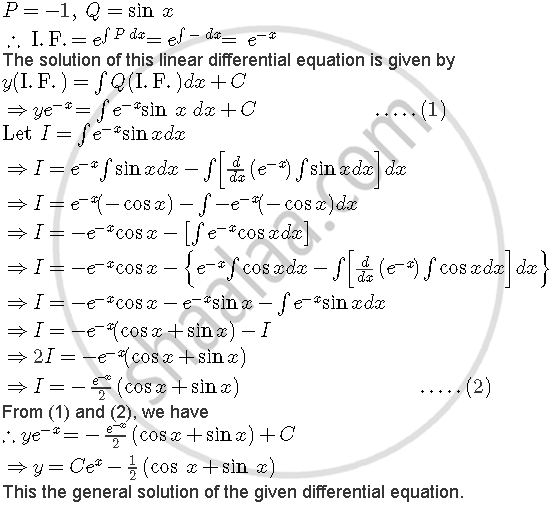Advertisements
Advertisements
Question
Find the general solution of the differential equation `dy/dx - y = sin x`
Solution
The given differential equation is
`dy/dx - y = sin x` .....(1)
Clearly, it is a linear differential equation of the form `dy/dx + Py=Q`
Here

APPEARS IN
RELATED QUESTIONS
For the differential equation, find the general solution:
`dy/dx + 3y = e^(-2x)`
For the differential equation, find the general solution:
`x dy/dx + 2y= x^2 log x`
For the differential equation, find the general solution:
`(x + 3y^2) dy/dx = y(y > 0)`
For the differential equation given, find a particular solution satisfying the given condition:
`dy/dx + 2y tan x = sin x; y = 0 " when x " = pi/3`
For the differential equation given, find a particular solution satisfying the given condition:
`dy/dx - 3ycotx = sin 2x; y = 2` when `x = pi/2`
Find the equation of the curve passing through the origin given that the slope of the tangent to the curve at any point (x, y) is equal to the sum of the coordinates of the point.
Solve the differential equation `x dy/dx + y = x cos x + sin x`, given that y = 1 when `x = pi/2`
x dy = (2y + 2x4 + x2) dx
dx + xdy = e−y sec2 y dy
Solve the following differential equation: \[\left( \cot^{- 1} y + x \right) dy = \left( 1 + y^2 \right) dx\] .
Solve the differential equation \[\frac{dy}{dx}\] + y cot x = 2 cos x, given that y = 0 when x = \[\frac{\pi}{2}\] .
Solve the following differential equation:
`cos^2 "x" * "dy"/"dx" + "y" = tan "x"`
Solve the following differential equation:
`("x" + 2"y"^3) "dy"/"dx" = "y"`
Solve the following differential equation:
y dx + (x - y2) dy = 0
Solve the following differential equation:
`(1 - "x"^2) "dy"/"dx" + "2xy" = "x"(1 - "x"^2)^(1/2)`
Solve the following differential equation:
`(1 + "x"^2) "dy"/"dx" + "y" = "e"^(tan^-1 "x")`
Find the equation of the curve which passes through the origin and has the slope x + 3y - 1 at any point (x, y) on it.
If the slope of the tangent to the curve at each of its point is equal to the sum of abscissa and the product of the abscissa and ordinate of the point. Also, the curve passes through the point (0, 1). Find the equation of the curve.
Form the differential equation of all circles which pass through the origin and whose centers lie on X-axis.
Integrating factor of the differential equation `(1 - x^2) ("d"y)/("d"x) - xy` = 1 is ______.
The integrating factor of the differential equation `x (dy)/(dx) - y = 2x^2` is
The integrating factor of differential equation `(1 - y)^2 (dx)/(dy) + yx = ay(-1 < y < 1)`
Let y = y(x), x > 1, be the solution of the differential equation `(x - 1)(dy)/(dx) + 2xy = 1/(x - 1)`, with y(2) = `(1 + e^4)/(2e^4)`. If y(3) = `(e^α + 1)/(βe^α)`, then the value of α + β is equal to ______.
Let y = f(x) be a real-valued differentiable function on R (the set of all real numbers) such that f(1) = 1. If f(x) satisfies xf'(x) = x2 + f(x) – 2, then the area bounded by f(x) with x-axis between ordinates x = 0 and x = 3 is equal to ______.
